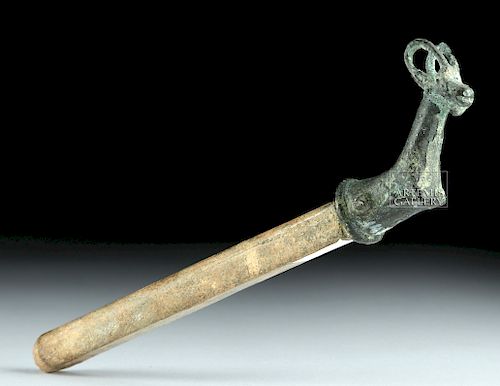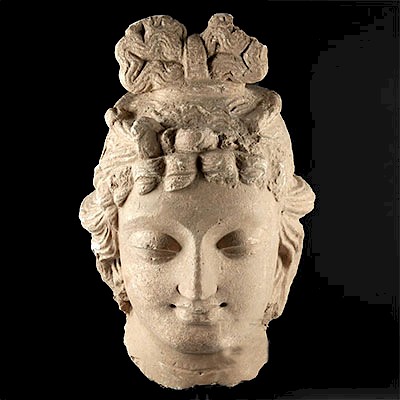Luristan Bronze & Stone Whet Stone w/ Ibex Handle
Lot 87a
About Seller
Artemis Fine Arts
686 S Taylor Ave, Ste 106
Louisville, CO 80027
United States
Selling antiquities, ancient and ethnographic art online since 1993, Artemis Gallery specializes in Classical Antiquities (Egyptian, Greek, Roman, Near Eastern), Asian, Pre-Columbian, African / Tribal / Oceanographic art. Our extensive inventory includes pottery, stone, metal, wood, glass and textil...Read more
Estimate:
$1,200 - $1,500
Absentee vs Live bid
Two ways to bid:
- Leave a max absentee bid and the platform will bid on your behalf up to your maximum bid during the live auction.
- Bid live during the auction and your bids will be submitted real-time to the auctioneer.
Bid Increments
| Price | Bid Increment |
|---|---|
| $0 | $25 |
| $300 | $50 |
| $1,000 | $100 |
| $2,000 | $250 |
| $5,000 | $500 |
| $10,000 | $1,000 |
| $20,000 | $2,500 |
| $50,000 | $5,000 |
| $100,000 | $10,000 |
| $200,000 | $20,000 |
About Auction
By Artemis Fine Arts
Aug 30, 2018
Set Reminder
2018-08-30 10:00:00
2018-08-30 10:00:00
America/New_York
Bidsquare
Bidsquare : Fine Antiquities / Asian / Ethnographic Art
https://www.bidsquare.com/auctions/artemis-gallery/fine-antiquities-asian-ethnographic-art-3402
Featuring classical antiquities, Asian, ancient and ethnographic art from cultures encompassing the globe, plus fine art. Artemis Fine Arts info@artemisfinearts.com
Featuring classical antiquities, Asian, ancient and ethnographic art from cultures encompassing the globe, plus fine art. Artemis Fine Arts info@artemisfinearts.com
- Lot Description
Ancient Near East, northwestern Iran, Luristan, ca. 1000 to 600 BCE. A cast-bronze whetstone finial handle depicting a graceful ibex in a leaping motion. The animal has a slender body with both front legs tucked underneath, an elongated neck, and a stylized head replete with almond eyes, a rounded snout, a short beard, and a pair of high-arching horns. The original bar-shaped whetstone still resides in the housing, with smooth edges and abraded sides indicative of heavy use. The handle is enveloped in a lustrous green and brown patina, making this a fabulous example from the ancient Near East! Size: 7.2" L x 2" H (18.3 cm x 5.1 cm).
Ordinary soldiers and people who would carry a knife to use as a weapon would carry a whetstone to sharpen the knife. However, an elite member of the community would have a special finial or handle like this example fitted to the whetstone. The ibex was an astronomical symbol of great importance from the earliest Near Eastern civilizations; some have suggested that it was at one time more important in Near Eastern iconography than the bull. What's more, some scholars have theorized that the animals depicted on Luristan weaponry were believed to possess apotropaic properties and could bestow their power on the objects they were sharpening.
Provenance: private East Coast, USA collection; ex-Arte Primitivo Gallery, New York, New York, USA
All items legal to buy/sell under U.S. Statute covering cultural patrimony Code 2600, CHAPTER 14, and are guaranteed to be as described or your money back.
A Certificate of Authenticity will accompany all winning bids.
We ship worldwide and handle all shipping in-house for your convenience.
#137796Repair to whetstone near base of bronze handle with small chips and light adhesive residue along break line. Surface wear and abrasions commensurate with age and use, slight bending to horns, fading to some finer details, and light roughness across most surfaces. Light earthen deposits throughout, and nice green and brown patina along handle.Condition
- Shipping Info
-
All shipping is handled in-house for your convenience. Your invoice from Artemis Gallery will include shipping calculation instructions. If in doubt, please inquire BEFORE bidding for estimated shipping costs for individual items.
-
- Buyer's Premium



 EUR
EUR CAD
CAD AUD
AUD GBP
GBP MXN
MXN HKD
HKD CNY
CNY MYR
MYR SEK
SEK SGD
SGD CHF
CHF THB
THB














